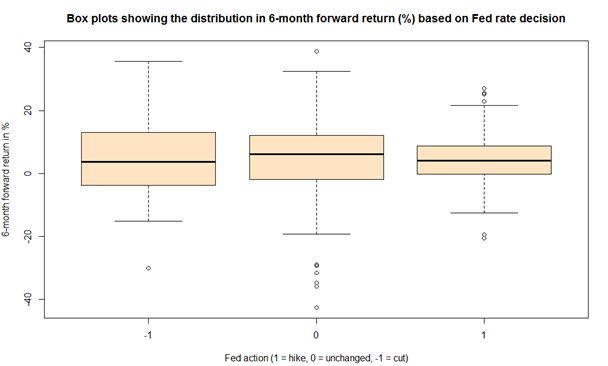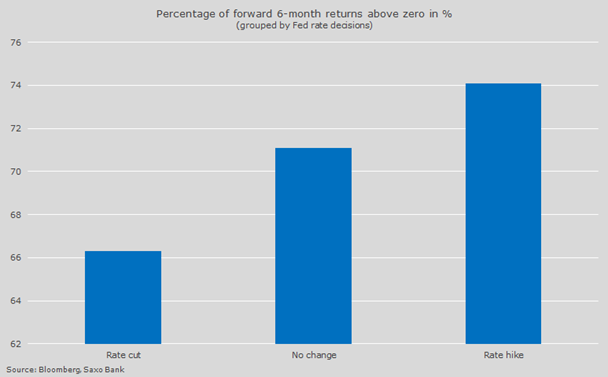Consensus appears to be building in support of the idea that the US economy is on the path to normalisation, eventually leading to higher interest rates. The market is currently signalling that the Fed will hike the Fed Funds target rate by 25 basis points at either its April 29 or June 17 meeting.
Based on the Jackson Hole speeches it is clear that, despite recent progress, further improvements in US labour markets are needed before the Fed becomes willing to act. It appears that Fed chair Janet Yellen regards the U-6 unemployment rate (which measures total unemployment plus all persons marginally attached to the labour force) as the preeminent measure of slack in the economy.

Source: Bloomberg
Fed hikes precede quiet gains
If we assume that the Fed will hike the Fed Funds Target Rate in 2015, then the immediate question concerns what will happen to equities.To answer the question, we analysed data from the S&P 500 and the Fed Funds target rate since 1975.
The conclusion, as illustrated by the box plot below (how to understand a box plot), is that the distribution of six-month forward returns is much narrower following Fed hikes than it is when rates are cut or left unchanged. In other words, rate hikes happen on the back of solid economic performance and improving data points. In such an environment, forward earnings projections are easier and more reliable and thus markets see less volatility in its discounting of the future. In short, equity markets go higher.
The plot also shows how a Fed cut has a very wide distribution. This can explained by how the rate cycle works: In the early phase, a rate cut comes on weakening economic data and sets expectations of worsening performance in motion. This translates into a large number of negative observations. At the end of the rate cycle, when the market believes the rate is not going lower, the sentiment is that "the worst is behind us," and the expectation is that the economy will improve. As a result, the 25% largest positive observations have a long tail.
Box plot: distribution of six-month forward returns following Fed rate decisions
 Source: Saxo Bank
Equity markets tend to gain following Fed hikes
Another more simple way to look at the data is to show how many times the forward six-month return is above zero following a Fed decision. The result is illustrated below. Contrary to conventional wisdom, a rate hike happens in a noisy environment where forward six-month outcome has a wide distribution. In other words, it is not necessarily a one-way trade.
More interestingly, our analysis shows that when the Fed hikes rates, the following six-month return is above zero 74.1% of the time. The next question, then, concerns whether this ratio is significantly different from the population's mean. Since 1975, the six-month return has been above zero 70.9% of the time, so what we want to find out is how the 74.1% of instances cited above differs from the "population", or the norm.
According to the population proportion test, the 95% confidence interval is 63.6% to 82.4%; in other words, we cannot reject the hypothesis that the two means are equal. The conclusion is that the higher "win ratio" for equities following a Fed hike is not significantly different from the population.
So based on these observations, being long equities is a good idea regardless of what the Fed does. This conclusion also fits with the efficient market hypothesis and reiterates that equity markets have a positive expected return.
Source: Saxo Bank
Equity markets tend to gain following Fed hikes
Another more simple way to look at the data is to show how many times the forward six-month return is above zero following a Fed decision. The result is illustrated below. Contrary to conventional wisdom, a rate hike happens in a noisy environment where forward six-month outcome has a wide distribution. In other words, it is not necessarily a one-way trade.
More interestingly, our analysis shows that when the Fed hikes rates, the following six-month return is above zero 74.1% of the time. The next question, then, concerns whether this ratio is significantly different from the population's mean. Since 1975, the six-month return has been above zero 70.9% of the time, so what we want to find out is how the 74.1% of instances cited above differs from the "population", or the norm.
According to the population proportion test, the 95% confidence interval is 63.6% to 82.4%; in other words, we cannot reject the hypothesis that the two means are equal. The conclusion is that the higher "win ratio" for equities following a Fed hike is not significantly different from the population.
So based on these observations, being long equities is a good idea regardless of what the Fed does. This conclusion also fits with the efficient market hypothesis and reiterates that equity markets have a positive expected return.

